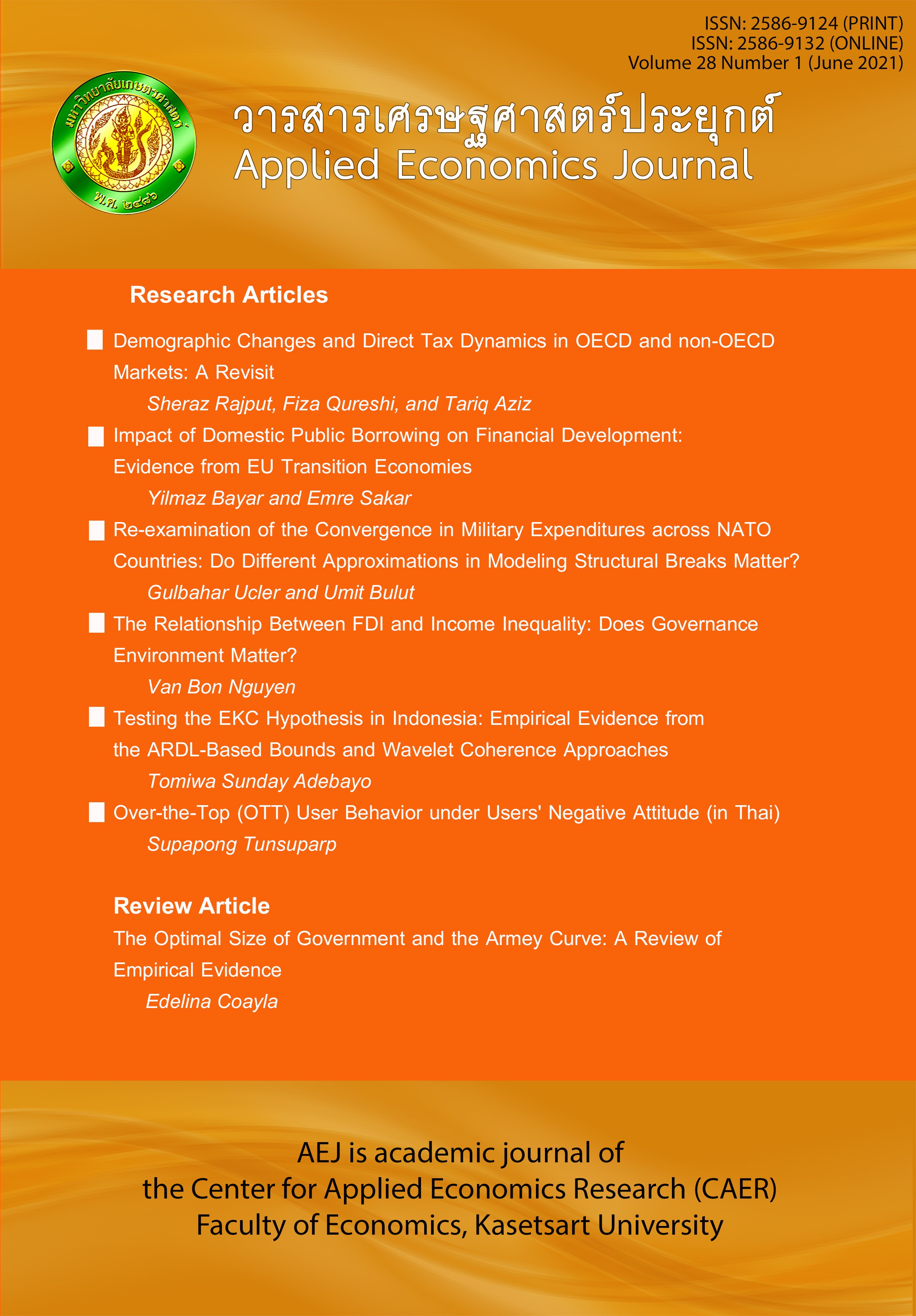The Relationship Between FDI and Income Inequality: Does Governance Environment Matter?
Main Article Content
Abstract
Reducing poverty and income inequality in society is considered one of the millennium goals in developing countries. Attracting more foreign direct investment (FDI) inflows to boost economic growth and development is a good solution to achieve this goal. This paper empirically assesses the role of the governance environment in the FDI–income inequality relationship for balanced panel data of 37 developing countries from 2002 to 2018 using the two-step generalized method of moments Arellano-Bond estimator. The estimated results indicate that FDI and governance reduce income inequality while their interaction enhances it. Furthermore, economic growth, trade openness, unemployment, education, and infrastructure are significant determinants of income inequality in the developing countries studied. In particular, the Pooled Mean Group estimator is employed to guarantee the robustness of estimates. The findings suggest some policy implications for governments of developing countries in terms of reforming the governance environment to attract more FDI inflows and decrease income inequality.
Article Details
The paper is published under CC BY-NC-ND, in which the article is freely downloaded and shared in its original form non-commercially and its citation details are identified.
References
Acemoglu, D., Johnson, S., & Robinson, J. A. (2005). Institutions as a fundamental cause of long-run growth. Handbook of Economic Growth, 1, 385-472.
Agosin, M. R., & Machado, R. (2005). Foreign investment in developing countries: Does it crowd in domestic investment? Oxford Development Studies, 33(2), 149-162.
Alili, M. Z., & Adnett, N. (2018). Did FDI increase wage inequality in transition economies? International Journal of Social Economics, 45(9), 1283-1304.
Arellano, M., & Bond, S. (1991). Some tests of specification for panel data: Monte Carlo evidence and an application to employment equations. The Review of Economic Studies, 58(2), 277-297.
Arellano, M., & Bover, O. (1995). Another look at the instrumental variable estimation of error-components models. Journal of Econometrics, 68(1), 29-51.
Chintrakarn, P., Herzer, D., & Nunnenkamp, P. (2012). FDI and income inequality: Evidence from a panel of US states. Economic Inquiry, 50(3), 788-801.
Cho, H. C., & Ramirez, M. D. (2016). Foreign direct investment and income inequality in southeast Asia: A panel unit root and panel cointegration analysis, 1990–2013. Atlantic Economic Journal, 44(4), 411-424.
Feenstra, R. C., & Hanson, G. H. (1997). Foreign direct investment and relative wages: Evidence from Mexico's maquiladoras. Journal of International Economics, 42(3-4), 371-393.
Figini, P., & Gorg, H. (2011). Does foreign direct investment affect wage inequality? An empirical investigation. The World Economy, 34(9), 1455-1475.
Helpman, E., Melitz, M. J., & Yeaple, S. R. (2004). Export versus FDI with heterogeneous firms. American Economic Review, 94(1), 300-316.
Herzer, D., & Nunnenkamp, P. (2013). Inward and outward FDI and income inequality: Evidence from Europe. Review of World Economics, 149(2), 395-422.
Herzer, D., Hühne, P., & Nunnenkamp, P. (2014). FDI and income inequality—Evidence from Latin American Economies. Review of Development Economics, 18(4), 778-793.
Holtz-Eakin, D., Newey, W., & Rosen, H. S. (1988). Estimating vector autoregressions with panel data. Econometrica: Journal of the Econometric Society, 56(6),1371-1395.
Huang, K., Sim, N., & Zhao, H. (2020). Does FDI actually affect income inequality? Insights from 25 years of research. Journal of Economic Surveys, 34(3), 630-659.
Judson, R. A., & Owen, A. L. (1999). Estimating dynamic panel data models: A guide for macroeconomists. Economics Letters, 65(1), 9-15.
Kaufmann, D., Kraay, A., & Mastruzzi, M. (2011). The worldwide governance indicators: Methodology and analytical issues. Hague Journal on the Rule of Law, 3(2), 220-246.
Kaulihowa, T., & Adjasi, C. (2018). FDI and income inequality in Africa. Oxford Development Studies, 46(2), 250-265.
Khan, I., & Nawaz, Z. (2019). Trade, FDI and income inequality: Empirical evidence from CIS. International Journal of Development Issues, 18(1), 88-108.
Li, J. S. (2003). Relation‐based versus rule‐based governance: An explanation of the East Asian miracle and Asian crisis. Review of International Economics, 11(4), 651-673.
Li, S., & Filer, L. (2007). The effects of the governance environment on the choice of investment mode and the strategic implications. Journal of World Business, 42(1), 80-98.
Lin, S. C., Kim, D. H., & Wu, Y. C. (2013). Foreign direct investment and income inequality: Human capital matters. Journal of Regional Science, 53(5), 874-896.
Matallah, S. (2019). The triptych migration-inward FDI-inequality in South Asian countries: How much do governance and institutions matter? Migration and Development, 8(1), 93-118.
Pesaran, M. H., Shin, Y., & Smith, R. P. (1999). Pooled mean group estimation of dynamic heterogeneous panels. Journal of the American Statistical Association, 94(446), 621-634.
Roodman, D. (2009). How to do xtabond2: An introduction to difference and system GMM in Stata. The Stata Journal, 9(1), 86-136.
Rostow, W.W. (1960). The stages of economic growth – A non-communist manifesto. Cambridge: Cambridge University Press.
Teixeira, A. A., & Loureiro, A. S. (2019). FDI, income inequality and poverty: A time series analysis of Portugal, 1973–2016. Portuguese Economic Journal, 18(3), 203-249.
Westerlund, J. (2007). Testing for error correction in panel data. Oxford Bulletin of Economics and Statistics, 69(6), 709-748.
Wu, J. Y., & Hsu, C. C. (2012). Foreign direct investment and income inequality: Does the relationship vary with absorptive capacity? Economic Modelling, 29(6), 2183-2189.


